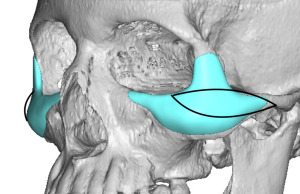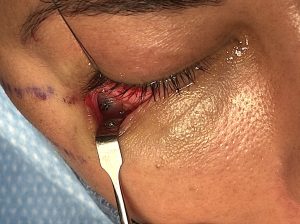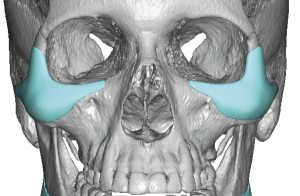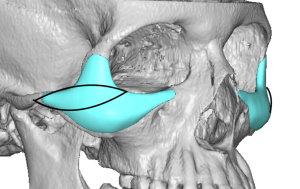Background: Optimal augmentation around the orbit and cheeks is ideally done with a custom implant design. Some aesthetic cheek augmentations need a significant orbital component, most commonly along the infraorbital rim but may also include the lateral orbital rim as well. Often the desire for such an implant design is learned from the use of proper standard cheek implants where too much lower or submalar cheek fullness result.
But even after the placement of custom cheek implant designs some patients may have learned that an even greater amount of projection of a specific cheek area may be additionally desired. One option would be to just make a whole new custom cheek implant design and that approach may be best for many patients. An alternative approach is that of an implant overlay technique. An overlay implant can be very effective and significantly reduces recovery and risks it but such patients have to be carefully selected.
Several important tenets to consider for an overlay implant is where is the additional projection needed, access for placement and the importance of implant fixation. An overlay implant should not need to extend/expand the footprint of the existing implant. It should be used for adding projection to the existing implant footprint and must be able to fit into the stretch of the existing implant pocket. The incision used to place the overlay implant should be the same one that was used to place the underlying initial implant. Some form of implant fixation is also needed to prevent the risk of implant shifting which is greater with an overlay implant.




Closure of the small lateral lower eyelid incision was done with small plain resorbable sutures. The swelling is expected to be far less than the 
The concept of an overlay implant for additional augmentation is based on a desire for less surgery, less recovery and overall less cost compared to a new custom implant design. In the properly selected patient it can be very successful but the key is in selecting the right custom implant on which to do it as well as limiting what the amount of augmentation that is needed. Fortunately by definition most patients that I consider for an overlay augmentation have only modest additional augmentation needs somewhat like putting icing on the cake.
Key Points:
1) Adding additional projection to an existing custom cheek implant was done using an overlay implant made from a standard cheek implant.
2) Through a prior lower eyelid incision a modified malar shell cheek implant was placed to add high lateral width only.
3) Screw fixation is necewesary through both the overlay and underlying cheek implants.
Dr. Barry Eppley
World-Renowned Plastic Surgeon






